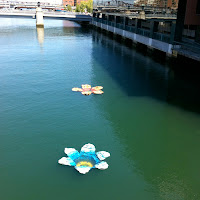
TM: I applied because I thought it would be a challenge to use the
tide in a sculptural installation. My first public art piece, outside of an, academic setting was in the empty storefront windows across from the Ritz on Avery Street. I did a kinetic installation composed of 40 carved wooden fingers mounted on suction cups attached to the inside of the windows. I placed a motionsensor above the sidewalk and as people walked by, the fingers would begin to tap on the window. I really liked the interactions I had with the people as I was working on the project. It took a couple of weeks to install so there was lots of explaining to people in the area about what I was doing.
FPAC: Very Cool! I am sure people were surprised as they walked by.
FPAC: What was the inspiration for Tidal Flowers? You had spoke of the recent oil spill as well as the great pacific garbage patch. Is other artwork that you produce about environmental issues?

TM: The first inspiration was from the movement of the tides and somehow using that as a function of the piece. As I paid more attention to the meaning of the work, the health of oceans, the “garbage patch”, and the oil spill all came together to define the piece. All of my work isn’t necessarily about the environment. I use a lot of recycled material because I like the history it contains. It’s an easy starting point for the work. But I don’t exclusively use recycled material. It depends on the idea and what it needs.
FPAC: What role do you believe artists are responsible for portraying to the public regarding economic, environmental and social issues.
TM: Artists have a great capacity for calling attention to these issues. I wouldn’t however call it a responsibility. Artists express themselves in unique and individual ways. To place the burden of politics and social trends upon the shoulders of artists is a sure way to destroy Art.
FPAC: There is quote from Dialogues in Public Art: " Just as architects were demonized as the destroyers of the city, artists were unrealistically asked to salvage it" (Tom Finkelpearl, P. 21.) ~In response to the striped down modern, city, metropolis designs that had taken over public building in the late 1950's. There was no dialouge between community and architect and ultimately the community felt left out. Artists were introduced to "save the day" by constructing art in public places.
FPAC: how do you think public art works temporary or permanent should be introduced to the community?.... often the dialogue is the most important relationship that needs to be considered? How have you created a dialogue with your work?
TM: My work poses more questions than it does answers. This in itself creates a dialogue. I feel that there is an openness in my work that invites viewers to express their opinions or curiosities. When successful, my work should function as a catalyst for debate and conversation.
FPAC: The shift from "plop art", or public art work that has been just placed without taking consideration the surroundings, to site specific work has been a big change in the art world over the last 20/30 years, how did you decide that the channel was a suitable site for your work?
TM: The site was the origin of this work. Because this is an annual commission and the location is already in place it wasn’t me making the decision of location. The most obvious fact of this site and what makes it unique is the tidal change. For me to ignore this would be like giving up the best opportunity the site has to offer.
FPAC: Where did you get all of the material used for your public art work?

TM: Casella Waste Management in Charlestown as well as local residents. Casella recycles for the city of Boston. Through Heidi Burbidge of the BRA I was able to get a 1400lb bale of crushed colored plastics. With the help of a couple of studio assistants I cut and cleaned all the bottles.
FPAC: how is your project being funded?
TM: Friends of Fort Point Channel is the main sponsor. I also got a small grant from the University of Rhode Island, Visual Arts Sea Grant.
FPAC: Where are you building these massive flowers?
TM: The folks over at Midway Studios were kind enough to let me use an empty studio for the duration of the project.
FPAC: How long have you lived in the Fort Point Channel?
TM: Since 1991
FPAC: Who or what are your biggest influences on your work?
TM: I tend to be influenced by things that peak my curiosity. I like to experiment and ask “What If “ a lot.
FPAC: What can we look forward to in the future from you?
TM: Currently I’m installing a two-person show with Heidi Kayser in The Schiltkamp Gallery at Clark University in Worcester Sept 20 – November 28th. I’m also installing a commissioned piece that I’ve been working on for the past year at Mass Art. It will be on view in the new campus center on Longwood Ave for the next 2 years. I’m a finalist for two other projects that I’ll find out about in the next month.

No comments:
Post a Comment